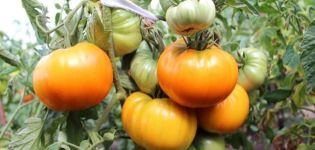Description of Purpurea Plena Elegance clematis, growing and pruning
A spectacular climbing liana that can decorate any suburban area is the Purpurea Plena Elegance clematis variety. A sophisticated variety of colors and luxurious blooms allow you to create magnificent compositions. Due to its unique qualities and ease of growing, lush and expressive clematis is ideal for beginner growers.
Description and features of the variety
Purpurea Plena Elegance looks like a curly luxurious liana, with magnificent double flowers of a dark burgundy color. On one small shoot, you can see a great many. Lush flowers do not exceed 10 centimeters in size and do not have stamens. The plant grows medium in size and reaches four meters in height. Its stems are densely covered with oval leaves. The root system goes deep into the soil.
For the lush flowering of this unpretentious vine, good lighting and warmth are required. Under cover, she easily tolerates severe frosts down to -40 ° C. Due to its large size, it requires the use of supports. Looks great against the backdrop of arbors, fences or walls of various buildings.
Breeding history Purpurea Plena Elegans
The variety was created in France over 100 years ago by mixing several different types of clematis.
Advantages and disadvantages
Purpurea Plena Elegance has many advantages and is suitable for the experiments of novice gardeners:
- perfectly tolerates even low temperatures;
- resistant to various diseases;
- grows intensively and pleases with active continuous flowering on an annual vine from June to September;
- not whimsical in leaving.
The variety has practically no disadvantages:
- needs good lighting;
- requires strong annual pruning; in its absence, weak flowering is observed the next year.
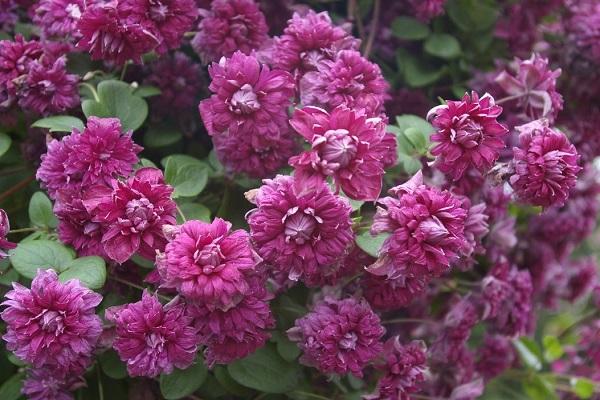
How to plant
After the threat of the last frost has passed, and the soil has warmed up enough, on a cloudy and warm day, you can start planting plants in open ground. Planting times are different for each region. On average, this is the end of May, June.
Seat selection
To grow Clematis Purpurea, choose a sunny area protected by a fence, wall or tall trees from drafts. Artificial shading during particularly hot midday hours will be the perfect protection against leaf burns and delicate flowers.
The choice of planting material
Today on sale you can find cuttings of two varieties:
- With an open root system, rooted last season. Such cuttings come with a peat ball, three or more developed roots and several buds.
- With a closed root system, sold in containers.
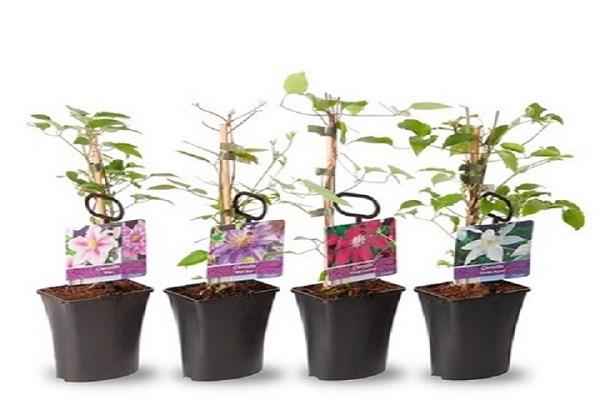
When buying seedlings, pay attention to the roots. They should be light and firm. Darkened areas of the root system require removal.
Clematis with non-hatching buds can be stored in the refrigerator or basement at a temperature not exceeding 5 ° C. A seedling with grown roots is immediately planted in a pot, deepening the neck by 2 centimeters.
The pot is placed in a bright place with an air temperature of 8-10 ° C.
Soil requirements
Clematis Purpurea loves fertile soil. Sandstone or loam with excellent drainage and weak soil acidity promote vigorous growth and lush flowering.
The root system goes deep into the ground, so nearby groundwater inhibits plant development and causes root rot. When growing in such areas, it is necessary to create artificial mounds or block the access of the root system to groundwater by laying a sheet of iron or slate in the planting hole.

Landing scheme
For the intensive development of powerful roots and abundant flowering when planting clematis, a number of rules should be followed:
- For a massive root, a deep planting hole is required, at least 50 centimeters deep.
- To prepare the soil, you will need: earth, peat and humus in equal proportions. A small amount of ash can be added to neutralize acidity.
- A drainage layer is laid at the bottom of the pit, a part of the finished soil mixture is poured out and a small mound is formed. A plant is planted on a mound, carefully spreading the roots.
- The planting hole is covered with earth so that the root collar of the seedling is buried 10 centimeters into the ground. This deepening contributes to the formation of a healthy, powerful bush. Clematis with a root collar located at ground level is doomed: such a plant practically does not bush, only a few stems are formed on it.
- To prevent the accumulation of moisture near the root collar and provide the roots with oxygen, the trunk circle around the entire perimeter is covered with a layer of mulch from sawdust, straw or humus.
- Each plant is intensively shed with water and a support is established.
- The spacing between plants should be at least 70 centimeters.
When planting clematis Purpurea with a closed root system, it is carefully taken out of the container and placed in the planting pit along with an earthen lump. The formation of a mound is not required for such a landing.
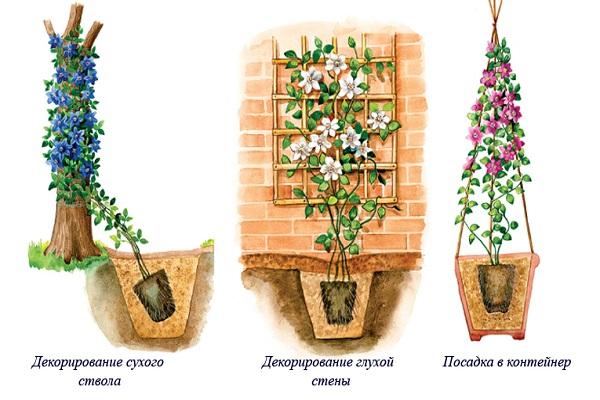
Care features
Clematis is unpretentious in care. For its active growth and flowering, it will be quite enough:
- timely watering;
- loosening the earth around the trunk circle;
- periodic feeding;
- annual pruning;
- protection against pests and various diseases.
Trimming group
Correct pruning is the guarantor of the annual abundant flowering of clematis. It promotes the formation of a powerful plant. If you skip timely pruning, next year weak flowering or complete absence of flowers is ensured.
Purpurea Plena belongs to the third pruning group, since the color is formed on fresh shoots that grow in spring. The plant requires radical pruning at a height of 10-15 centimeters. At the same time, two or three buds are left on young shoots.
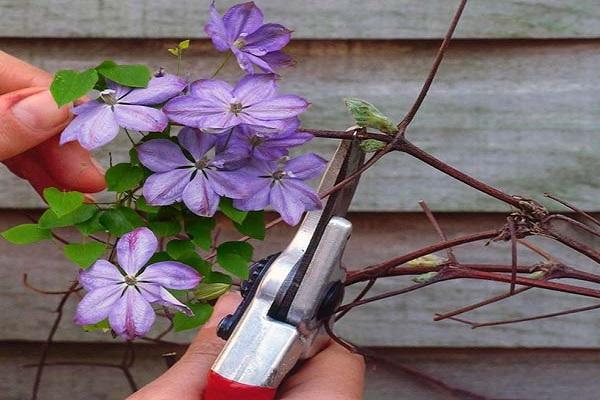
Pruning is done in the fall. With the arrival of warm days and the restoration of the intensive movement of the juice with such pruning, the plant becomes more active and grows without putting nutritious juices into old unnecessary branches. Deep pruning also increases the winter hardiness of the plant, prevents the roots from freezing at prolonged subzero temperatures.
Watering
Lack and excess of moisture negatively affect the growth and development of Clematis Purpurea, reduce the period and intensity of flowering. When growing it, avoid strong drying out of the earth. Watering should be moderate and regular. During prolonged droughts, the plant needs abundant watering.
It is advisable to water Clematis Purpurea late in the evening. During a cool night, moisture will have time to soak into the soil and saturate the plant. When watering in the morning, a large amount of moisture evaporates and does not reach the roots.
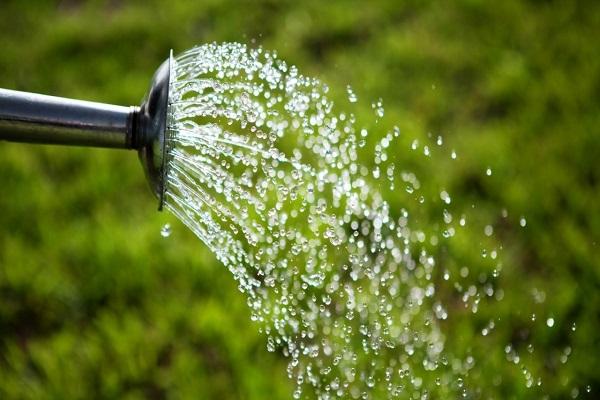
Top dressing
Clematis is fed in small portions, alternating organic and mineral fertilizers. Fertilizers are applied no more than four times per season. During the flowering period, Clematis is not fertilized.
Shelter for the winter
In regions with cold winters, clematis requires reliable shelter. With the arrival of the first frost, the base of the plant is covered with humus, peat, sawdust or dry leaves. The plant is covered with lutrasil or any other covering material.
Protection from spring waters
Drainage grooves laid along the near-trunk circle and filled with sand or gravel, as well as diversion furrows, will help to reliably protect the vines from spring floods. At the base of the plant, to protect against water, small mounds of peat or humus can be formed.
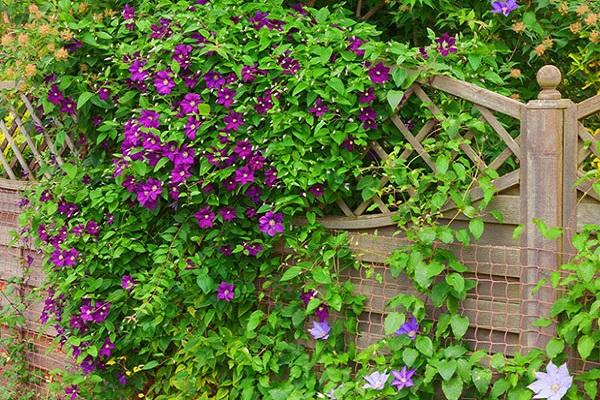
Support
The height and heavy weight of the vines require the use of reliable supports. To do this, use:
- fences;
- walls of buildings;
- garden gazebos;
- metal arches:
- wooden nets;
- openwork pergolas;
- mesh netting;
- racks.
Whatever support is used at the summer cottage - Purpurea Plena is elegant and beautiful in any form.
Mulching and loosening the soil
Free access of oxygen is necessary for the development of a powerful root system and the plant as a whole. Clematis needs periodic loosening of the soil. Loosening is especially important after heavy watering or a period of prolonged rains.
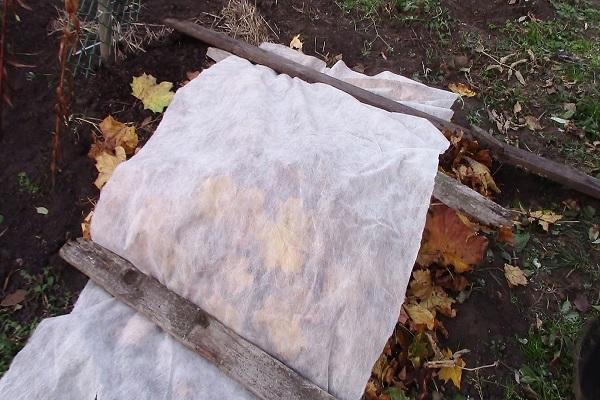
Mulching the trunk circle will help to avoid loosening, retain moisture and prevent the formation of weeds. To do this, you can use compost, sawdust, straw, dry leaves and even cones..
Diseases and pests
Clematis is resistant to most types of diseases, but some of them are still dangerous for vines.
Rot
The change in the green color of the leaves to a brown and whitish bloom speaks of developing gray rot. The reason is an excess of moisture. The affected areas are cut and burned, and the plant is treated with a solution of basezole or azocene.
Powdery mildew
A whitish bloom on shoots and leaves speaks of powdery mildew. For treatment, the plant is treated with foundation, azocene or topaz.
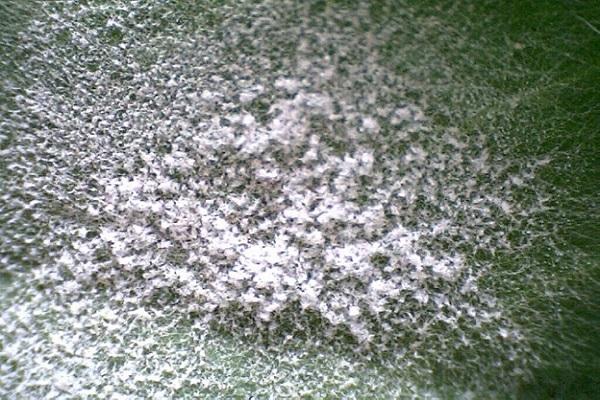
Harmful insects
Clematis love:
- aphid;
- bear;
- spider mite;
- slugs.
Timely treatment with chemicals will help save the plant from serious damage and death.
Rodents
To protect clematis Purpurea in winter from rodents, various baits are laid around the trunk.
Reproduction
Purpurea Plena can be easily diluted with seeds, dividing the bush, cuttings and layering.
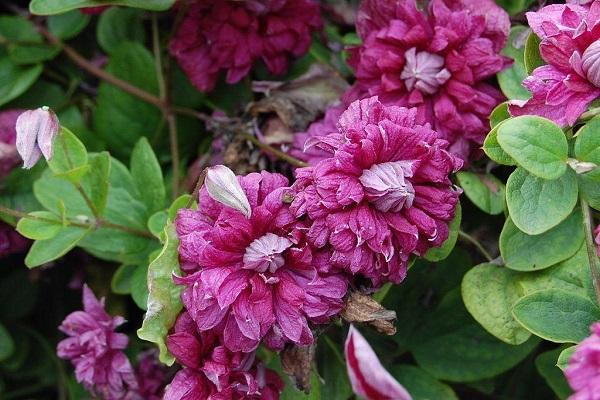
Division of bushes
To breed clematis by dividing, dig up a plant no older than seven years and carefully divide it into parts. Each formed bush is planted in a prepared planting pit, after treating the root system with a rooting agent.
Layers
In early spring, healthy young shoots are bent down and covered with earth. After the roots appear, the layers are cut off from the mother bush and transplanted.
Cuttings
With the onset of warm spring days, you can start breeding Clematis Purpurea by cuttings. To do this, cut off the middle part of the young shoot and place it for rooting in a wet mixture of humus and sand. The rooted stalk is transplanted into open ground.
Use in landscape design
Clematis Purpurea is ideal for growing in a garden, terrace or veranda. It will effectively decorate:
- garage or barn wall;
- fences and similar fences;
- house facade;
- arches and pergolas.
Reviews
According to the owners, Purpurea Plena Elegance needs careful care. It's not easy to work with, but it's worth it.









